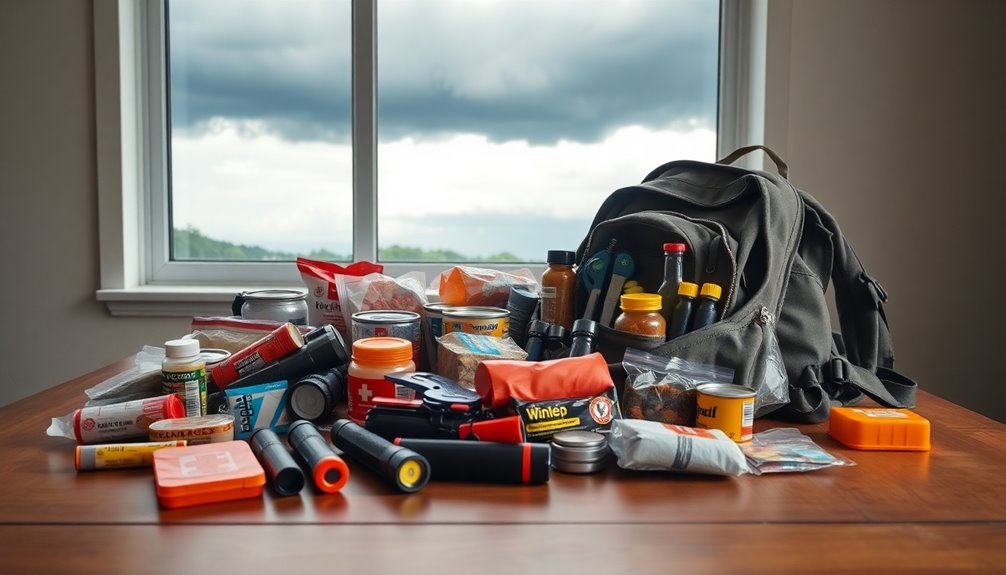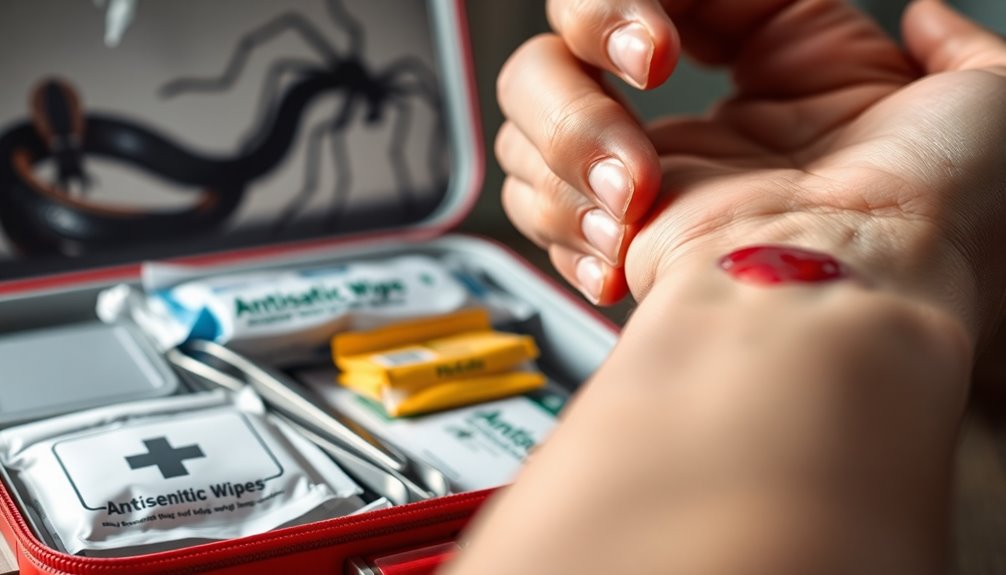To make char cloth in a tin can, start by choosing natural fabric like cotton or linen and cut it into small pieces. Clean the can thoroughly and fill it with the fabric, sealing it tightly. Place the can over a steady flame in a well-ventilated outdoor area and monitor the process carefully. Once the smoke decreases, let the can cool completely before opening to retrieve your char cloth. Continue to explore more tips for safe and successful results.
Key Takeaways
- Use a clean, natural fabric like cotton or linen, cut into small pieces, and place them inside a sealed, sturdy metal tin can.
- Ensure the can is free of rust, holes, or leaks, and fill it evenly without overpacking for proper airflow.
- Heat the closed can over a steady flame in a well-ventilated area, wearing safety gear and keeping fire safety tools nearby.
- Monitor the heating process for signs of overheating, smoke, or flames, and allow the can to cool naturally before opening.
- Carefully extract the cooled char cloth using tongs, then store it in a dry, airtight container away from heat or sunlight.
Gathering Materials and Preparing Your Workspace
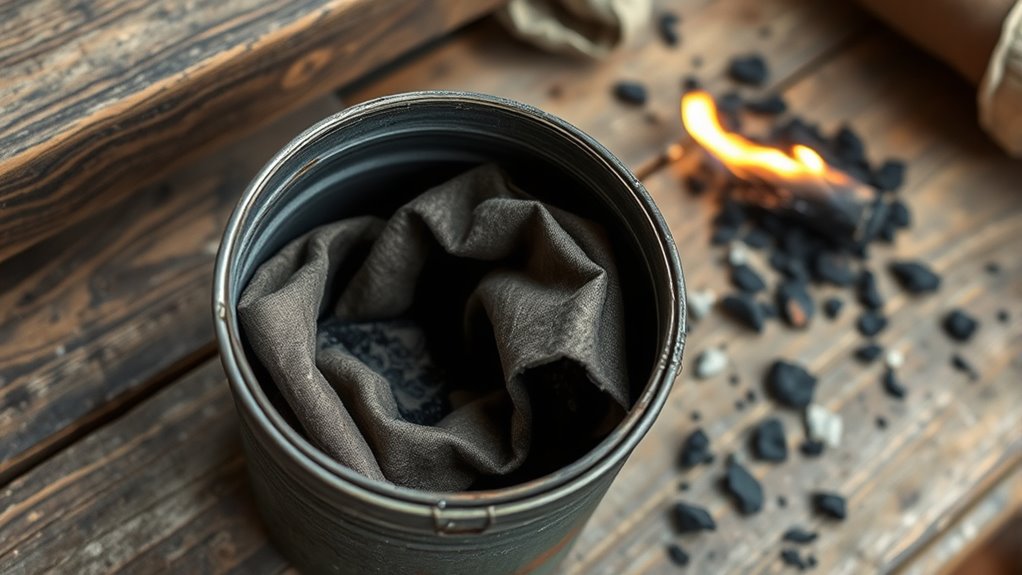
Before you begin making char cloth, you need to gather all the necessary materials and set up a safe, organized workspace. Prioritize fire safety by choosing a well-ventilated area away from flammable objects. Select your fabric carefully; natural fibers like cotton or linen work best because they char evenly. Avoid synthetic fabrics, which won’t produce quality char cloth and could be hazardous when heated. Keep a fire extinguisher or a bucket of water nearby in case of emergencies. Make sure your workspace has a heat-resistant surface to work on and clear it of clutter. Organize your materials—tin cans, fabric, matches, or a lighter—so everything is within reach. Proper preparation guarantees a safe, efficient process and helps you produce the best char cloth possible. Additionally, understanding the optimal angles for pinball machines can help you set up your workspace for better airflow and safety during the process. Ensuring proper attention in your workspace allows you to stay focused and avoid accidents. To further enhance safety, familiarize yourself with basic fire safety tips relevant to open-flame projects. Incorporating knowledge about fire hazards can also help you prevent potential dangers during the process.
Selecting and Cutting the Fabric for Char Cloth
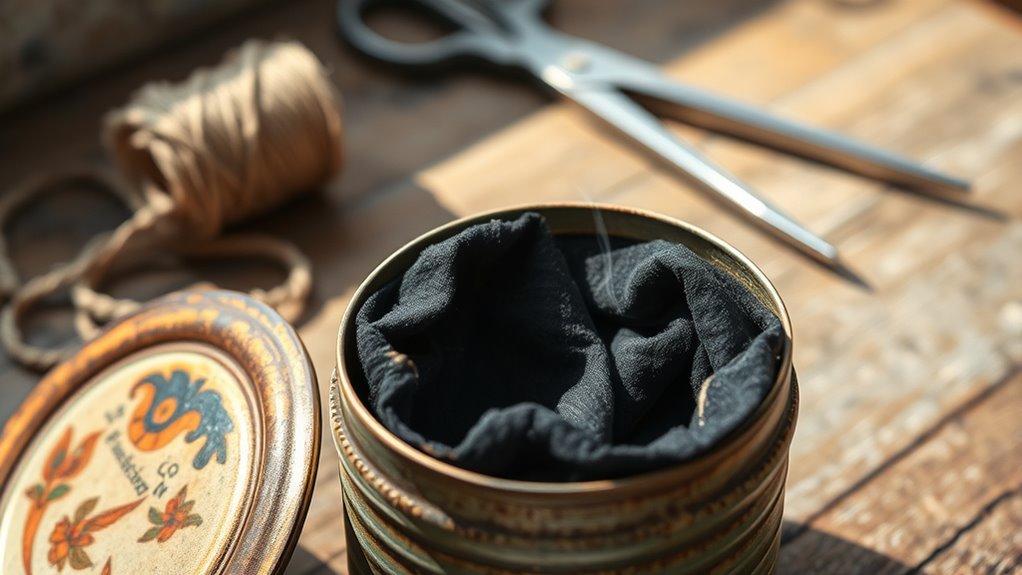
Choose a natural fabric like cotton or linen that will char well without burning completely. Use sharp scissors to cut the fabric into small, manageable pieces, guarantee they fit comfortably in your tin can. Prepare each piece by removing any dyes or synthetic fibers to ensure a clean, effective char cloth. Additionally, ensure the fabric is free of any flammable contaminants that could ignite unexpectedly during the charring process. Being aware of fire safety precautions is essential to prevent accidents and ensure a safe charring experience. Incorporating knowledge of automation in business can help optimize the process for efficiency and safety. Recognizing quality control measures can further ensure your char cloth is safe and effective for use. Implementing proper storage practices can also help maintain the integrity and safety of your fabric before and after processing.
Choosing Suitable Fabric
Have you ever wondered what kind of fabric works best for making char cloth? Choosing the right fabric is essential for good results. Look for material with high fabric durability, so it withstands the charring process without falling apart. Opt for natural fabrics like cotton or linen, which burn evenly and produce quality char cloth. When considering color selection, stick to plain, undyed fabrics—white or off-white works best—since dyes can affect the burning process. Avoid synthetic or heavily patterned fabrics, as they won’t produce reliable char cloth. Keep your selection simple to guarantee consistent results. Remember, the fabric’s quality and type directly impact the effectiveness of your char cloth, so choose carefully to make your project successful. Understanding fabric properties can help you select the best material for optimal results. Additionally, considering fire-resistant qualities can improve the safety and efficiency of your process. Being aware of fabric composition helps ensure you choose materials that will char properly and safely. Recognizing how different fabrics react to heat can further guide your selection process for better outcomes.
Cutting Fabric Properly
To prepare your fabric for making char cloth, start by selecting a piece that’s clean, dry, and free of dyes or patterns. Choosing the right fabric types, like cotton or linen, guarantees better results. When cutting, use sharp scissors or a rotary cutter to make clean, precise cuts. Follow consistent cutting techniques to avoid frayed edges and ensure uniform pieces. Here’s a quick guide:
| Fabric Types | Cutting Techniques | Tips |
|---|---|---|
| Cotton | Straight cuts | Use sharp scissors |
| Linen | Precise angles | Cut into small squares |
| Hemp | Clean edges | Avoid fraying |
Proper cutting helps your char cloth burn evenly and safely, making the process more efficient. Additionally, understanding the best tools for cutting can improve your overall results. Using the appropriate cutting tools not only enhances precision but also reduces fabric waste. Incorporating sound healing science principles, such as using specific frequencies, can also enhance your crafting experience by promoting focus and relaxation during the process. Being aware of payment processing methods can also assist if you decide to purchase tools or supplies online securely. Moreover, selecting sustainable fabrics supports eco-friendly crafting practices and reduces environmental impact.
Preparing Fabric for Char
Before cutting your fabric, make sure it’s clean, dry, and free of dyes or patterns, as these can affect the quality of your char cloth. Using untreated, natural fabric like cotton or linen works best for textile preservation and ensures consistent results. Properly selecting your fabric helps maintain the integrity of your final product. When preparing for fabric dyeing, choose plain, undyed material to avoid unwanted colors or chemicals that could hinder the char cloth’s effectiveness. Cutting the fabric into small, even pieces makes the charring process more uniform and manageable. Keep these tips in mind: practical support — ensuring the fabric’s suitability can help prevent issues during the fabric charring process. Additionally, selecting fabrics with appropriate fiber content can influence the durability and performance of your char cloth, and understanding fiber properties is beneficial in making the best choice.
Preparing the Tin Can for the Burning Process
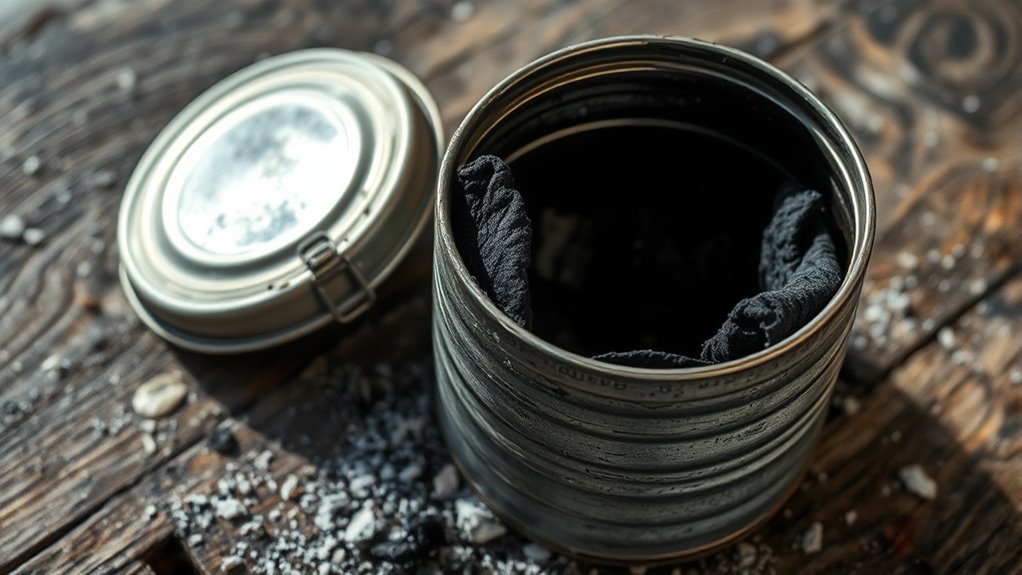
Preparing the tin can is a crucial step to guarantee a safe and effective char cloth-making process. First, choose a sturdy metal can with a secure lid to prevent fumes from escaping. Inspect the can for rust or damage, replacing it if necessary. To ensure proper sealing, use sealing techniques like tightening the lid firmly or adding a gasket if possible. Make sure the can has no holes or leaks that could allow smoke or gases to escape uncontrollably. Clean the can thoroughly to remove any residues or contaminants. Proper preparation helps contain the smoke and prevents dangerous fumes from escaping during burning. This step ensures safety and consistency, allowing you to produce high-quality char cloth efficiently.
Filling the Can With Fabric and Sealing It Properly
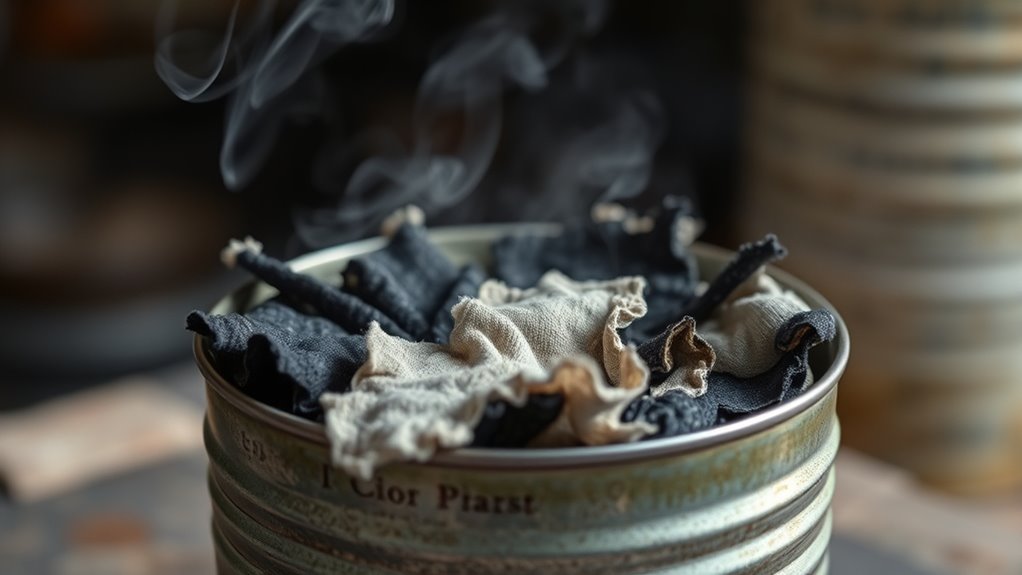
Once you’ve chosen your fabric, carefully cut it into small, manageable pieces that will fit comfortably inside the can. Proper fabric selection is essential for making quality char cloth, so choose natural, breathable materials like cotton or linen. When filling the can, guarantee you don’t overpack it, allowing some airflow for the burning process. To maximize fire safety, double-check that the lid seals tightly to prevent fumes from escaping.
Remember these key points:
- Use breathable, natural fabrics like cotton or linen
- Fill the can evenly without overpacking
- Seal the lid tightly for safe, effective burning
Following these steps helps produce better char cloth while keeping safety a top priority.
Setting Up Your Outdoor Fire Area Safely

Start by choosing a safe spot away from overhanging branches and flammable materials. Clear the area of leaves, twigs, and debris to prevent unintended fires. Always have proper fire tools nearby, like a shovel and fire extinguisher, to stay prepared.
Choose a Safe Spot
Choosing a safe spot for your outdoor fire is essential to prevent accidents and protect your surroundings. A well-chosen location promotes proper fire safety and helps keep your workspace organized. Look for an area away from overhanging branches, dry grass, or other flammable materials. Verify the ground is flat and non-combustible, such as dirt, gravel, or stone. Keep a water source or fire extinguisher nearby for emergencies.
- Clear the area of debris and leaves before starting
- Maintain a safe distance from structures and trees
- Confirm there’s enough space for safe fire management
Selecting a good location minimizes risks and makes your fire-building process smoother. Proper workspace organization and fire safety are key to enjoying your outdoor project responsibly.
Clear Surroundings Thoroughly
Before lighting your fire, thoroughly clear the area of leaves, sticks, and other combustible debris to reduce the risk of unintended spreading. Maintaining good fire safety involves creating a safe workspace organization that minimizes hazards. Remove any materials that could catch fire easily and ensure the ground is clear of clutter. Clear surroundings help prevent accidental fires and allow you to focus on controlling your fire effectively. A tidy, organized space also makes it easier to manage your tools and monitor the fire’s progress. By taking these precautions, you reduce potential hazards and promote a safer outdoor environment. Always double-check that the area is free of debris before igniting your fire to guarantee responsible and safe outdoor cooking.
Use Proper Fire Tools
Using proper fire tools is essential for setting up your outdoor fire area safely and efficiently. Choosing the right tools helps maintain fire safety and prevents accidents. Select tools designed for outdoor fires, such as fire pokers, tongs, and a sturdy shovel. These tools allow you to handle logs and embers safely without risking burns or mishandling fire. Proper tool selection ensures you can control the fire properly and respond quickly if needed. Keep a fire extinguisher or a bucket of water nearby as an extra safety measure. Always inspect your tools before use, ensuring they’re in good condition. Employing appropriate fire tools not only enhances safety but also makes managing your fire more effective and enjoyable.
Heating the Tin Can to Create Char Cloth
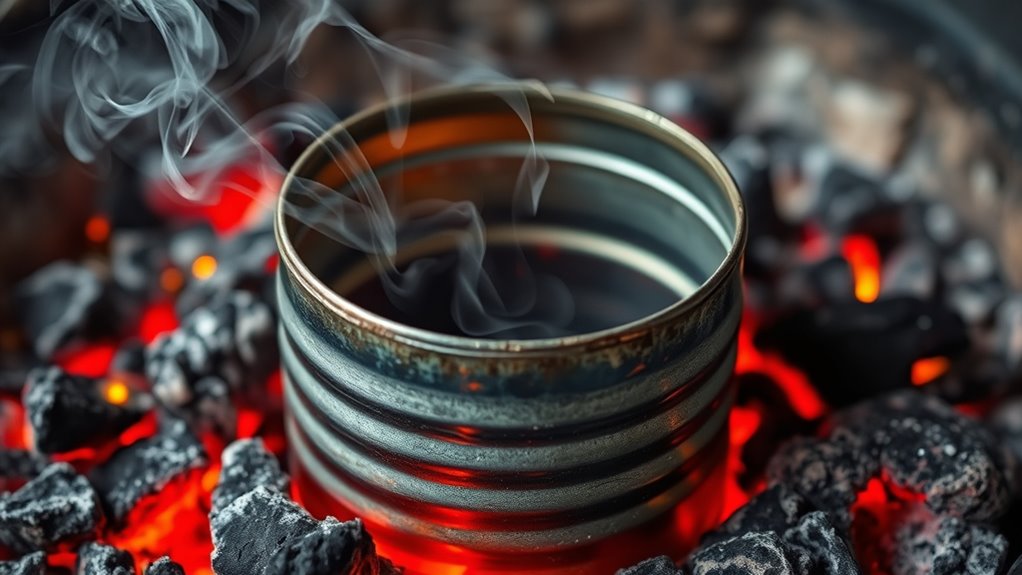
Have you ever wondered how to transform a simple tin can into a source of char cloth? To do this safely, focus on fire safety and proper material selection. Choose a metal can that can withstand high heat without melting or warping. Make sure you’re in a well-ventilated area, away from flammable objects. When heating the can, place it over a steady flame, and don protective gloves and safety glasses. Keep a fire extinguisher nearby in case of emergencies. As the can heats, the material inside will begin to carbonize, turning into char cloth. Stay attentive during this process to prevent accidents. Proper material selection and fire safety precautions are key to successfully making your char cloth without mishaps.
Monitoring the Process During Heating

As you heat the tin can, it is crucial to closely monitor the process to guarantee safety and achieve the desired char cloth. Keeping an eye on the heat ensures you don’t accidentally start a fire or overcook the material. Use a heat-resistant glove to check the can’s color and listen for signs of combustion. Regularly observe for smoke or unusual smells, which indicate overheating.
- Watch for smoke or flames to prevent fire safety hazards
- Use a thermometer or visual cues to monitor temperature
- Adjust the heat source as needed to maintain a steady, safe temperature
Allowing the Can to Cool and Handling the Char Cloth

Once the can cools naturally, you can carefully handle it with tongs to avoid burns. Let the char cloth cool completely before touching it with bare hands, and store it in a safe, dry place. Taking these steps guarantees your safety and keeps your char cloth in good condition.
Cool Down Naturally
Ever wondered why patience matters when cooling char cloth? Allowing the can to cool naturally guarantees the fabric preparation process is complete without risking fire safety. Rushing the cooling can cause the char cloth to crack or become unusable. While waiting, keep the can away from flammable materials and ensure proper ventilation.
You can enhance safety and quality by:
- Avoiding opening the can too soon, which can trap heat and cause sparks
- Using protective gloves when handling the hot can after cooling
- Ensuring the can cools completely before removing the lid or handling the char cloth
Patience helps preserve the integrity of your char cloth and keeps your workspace safe. Let it sit undisturbed until it reaches room temperature.
Use Tongs Carefully
When handling the cooled can and char cloth, it’s vital to use tongs carefully to prevent burns or accidental drops. Tongs safety is essential, especially since the can may still be warm or hot. Grip the can firmly with the tongs, ensuring a secure hold before moving it. Always handle the char cloth with care to avoid tearing or scattering ashes. Follow handling precautions by keeping your hands clear of the heat source and working on a stable surface. If the can feels too hot, wait a few extra minutes before touching it directly. Using tongs correctly minimizes the risk of burns and keeps the process safe. Remember, patience and careful handling are key to avoiding accidents during this stage.
Store in Safe Place
After carefully handling the char cloth and can with tongs, it’s important to let everything cool completely before moving or storing it. This prevents accidental burns and guarantees fire safety. Once cooled, choose a secure, dry storage solution away from heat sources and flames. Proper storage keeps the char cloth safe and ready for use.
- Keep it in a fireproof container or metal tin to prevent accidental ignition
- Store in a cool, dry place away from direct sunlight or heat
- Avoid clutter or cluttered areas that could cause damage or fire hazards
Extracting and Storing Your Homemade Char Cloth
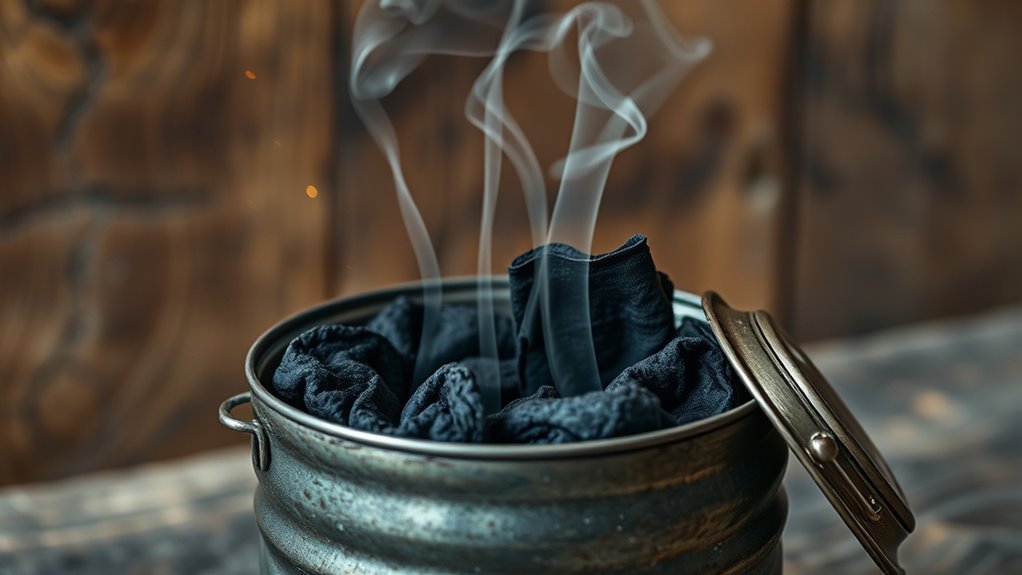
Once your char cloth has cooled completely, carefully remove it from the tin can to prevent accidental burns or damage. Handle the fabric gently, avoiding tearing or folding that could compromise its effectiveness. When extracting, prioritize fire safety—ensure you’re working in a safe, non-flammable area and keep a fire extinguisher nearby. Choose fabric wisely; natural fibers like cotton or linen work best, as they produce quality char cloth. Once removed, store your char cloth in a clean, airtight container to keep it free from dust and moisture. Proper storage preserves its ability to catch a spark easily. Keep it out of direct sunlight and in a cool, dry place. Taking these steps ensures your homemade char cloth remains safe, effective, and ready for your next fire-starting adventure.
Tips for Using and Maintaining Your Char Cloth
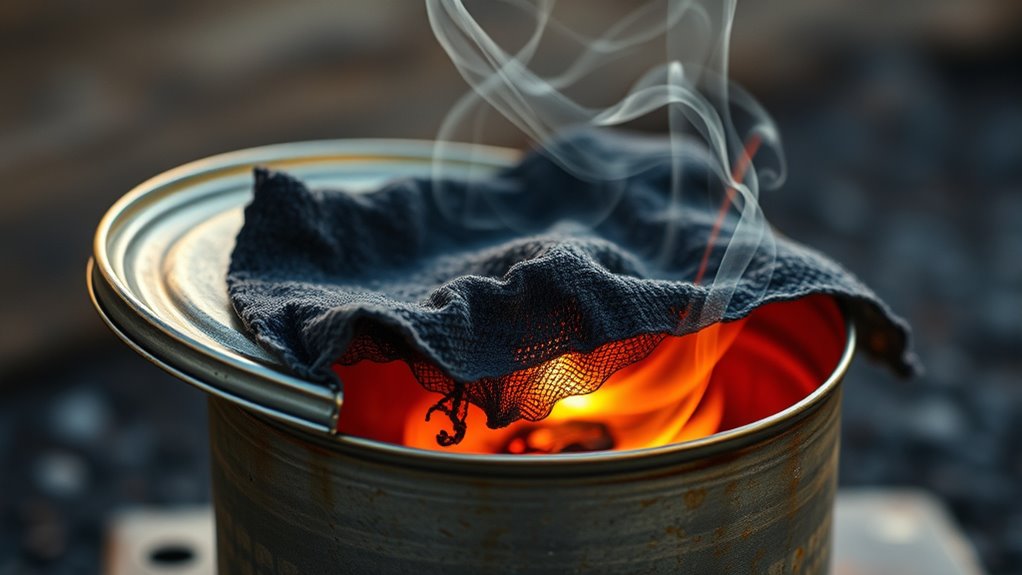
Properly using and maintaining your char cloth guarantees it remains effective and ready when you need it. Always handle it with care to avoid tears or contamination. When storing, keep it in a sealed container to preserve its properties and support fire safety. Regularly inspect your char cloth for signs of damage or moisture, replacing it if needed. For fabric selection, choose natural, tightly woven materials like cotton or linen; synthetic fabrics won’t produce good char. Keep your workspace clean and free of flammable materials to ensure fire safety.
- Store in a dry, airtight container
- Use natural fabrics like cotton or linen
- Handle with care to avoid tears or contamination
Frequently Asked Questions
How Long Does the Charring Process Typically Take?
The charring duration varies depending on heat application, but it generally takes around 15 to 30 minutes. You should keep the heat steady and avoid opening the container too soon, as it can disrupt the process. Monitoring the color change to a black, brittle state indicates completion. Once the process is complete, let it cool before handling to make certain you get quality char cloth.
Can I Reuse the Can for Multiple Batches?
Oh, sure, why not turn your tin can into a storage dynasty? Reusing tins for multiple batches is totally doable—just clean and inspect them first. Think of it as eco-friendly batch storage, saving you money and time. Keep in mind, repeated use might weaken the can’s integrity, so watch for rust or warping. With some care, your tins can become the trusty vaults of your char cloth empire!
What Are the Signs That the Process Is Complete?
When you’re checking if the process is complete, look for smoke cessation and a consistent color change. The smoke should stop entirely, indicating the char cloth is ready. The fabric will turn a dark, almost black color, with no more visible smoke or fumes. This change means the carbonization process is finished. Keep a close eye to avoid overcooking, which can burn the material and ruin your char cloth.
Is There an Alternative Method to Make Char Cloth Without a Tin Can?
You might wonder if there are DIY alternatives to make char cloth without a tin can. Absolutely, you can use safe container options like a metal or ceramic bowl with a lid, a heat-safe glass jar, or a small clay pot. Just guarantee the container is airtight and can withstand high temperatures. Always work in a well-ventilated area and take safety precautions to avoid burns or fire hazards.
How Do I Know if the Char Cloth Is Fully Cooled and Safe to Handle?
You’ll know your char cloth is fully cooled when the cooling time has elapsed, and it’s cool to the touch. To guarantee handling safety, wait until it no longer feels warm or hot. Avoid rushing this process to prevent burns or damage. Once it’s completely cooled, you can handle it safely, knowing it’s ready for use. Patience during cooling guarantees both safety and a quality piece of char cloth.
Conclusion
Making char cloth in a tin can is simple, rewarding, and gives you a handy fire-starting tool. Think of it as crafting a tiny piece of history that’s just as useful today as it was centuries ago. With patience and care, you’ll create a piece of gear that’s as reliable as an old friend. So, get your supplies ready, follow the steps, and enjoy the satisfying process of making your own char cloth.




